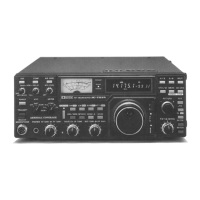The
output from
the filter
is
converted
to
a 9MHz
signal
again by
the IC11 mixer
through
the
Q42
buffer
amplifier.
FM
signals
from
the FI6
filter are fed
to
a special
FM
circuit.
The
9MHz
signal
is
supplied
to an amplifier
circuit
consisting
of
Q43
and
Q44,
then
is
supplied
to
the
AGC
or the
DETECTOR
circuit.
Finally,
the
signal
is
fed
to the AF
amplifier
circuit.
FM signals
from
FI6
are
supplied
to
amplifier
and
limiter
circuits
consisting of
IC12,
Q45
and
IC13.
The
limiter
circuit
eliminates
noise
or
AM
components,
then
the
signal
is
supplied
to
a
frequency
discriminator
and is
detected.
The
detected
signal
passes
through
a
C-R network for
de-emphasis
and
is
supplied
to the AF
amplifier
circuit.
The
AF
amplifier
circuit
consists of
a pre-amplifier
and
an AF
power
amplifier
which amplifies
the
signal
to
a
sufficient
level
to drive
a
speaker.
A switching circuit
consisting
of Q74
and
Q75
is installed
at
both
the Input and
output of
the
pre-amplifier
circuit
in order
to cut off
the
AF signal by means
of
a squelch
signal.
The
output from
the
pre-amplifier is also
supplied
to the
ACC
socket
on the
rear
panel.
The AF
signal from the
detecter
circuit
is
amplified
by IC19
(b).
Then It is
fed
to the IC19
(a) pre-amplifier
through
the
TONE
CONTROL circuit consisting
of
R394,
C258 and
the
TONE CON-
TROL on
the
front
panel. The
signal is
supplied
to the IC18
AF
power amplifier through
the AF
GAIN
CONTROL
on the
front
panel. The AF
power amplifier
has
a 2.6W output capability under
an
8
ohm
load
with
10% distortion.
11-2
TRANSMIT
CIRCUITS
(1)
AF CIRCUITS
•
MAIN
UNIT
•
RF
COMPRESSOR
•
RF
UNIT
The AF signal from the mic
connector
is fed
through
the MIC
GAIN
CONTROL
on
the
front
panel
to
Q34 and
Q35 where
the signal
is
amplified.
The tone
control circuit
is installed
between
034 and
Q35,
and
varies the frequency
response
of the
mic amplifier.
The
signal Is also supplied
to the ACC
socket through
R148 and
C83.
IC9
is a
double-balanced
mixer which
generates
the SSB
and AM
signals.
IC9 puts
out DSB signals formed
by the AF signal mixing
with the
BFO signal. In the AM
mode,
an
offset
voltage is fed
to
the
modulating input
terminal of
IC9 through
R159 and D75
so
the
carrier
level
may be controlled
by simply adjusting
the offset voltage.
The DSB or AM signal from
IC9
is
fed
to
the 9MHz
filter and the
filter eliminates one
sideband resulting in an
SSB signal. The signals
are fed through
Q84 to the ICIO mixer.
IC10
puts
out a
455kHz
signal which
is
fed
to
the
Q38 matching amplifier through the
Speech
Compressor
circuit
when the circuit
is
turned
ON. Then the
signal
is
converted
to
9MHz
again,
and is
fed
to the transmitter
IF
amplifier
by Q1.
The
9.0115MHz IF
signal from the MAIN unit passes through the
LPF and
is converted
to
70.451 5MHz
by the
ICS double-balanced
mixer. The HPF
eliminates the 9.0115MHz signal component from
the
mixer
output signal, and the
L30
and
C67
resonator eliminate
the 61.44MHz 2nd
LO signal component.
The
signal
is
amplified
by
the Q1
1
dual-gate FET
which receives
an ALC
voltage
at its 1st gate.
-
50
-

